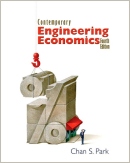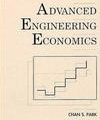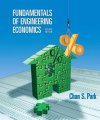What is new?
In the complex and changing world of a global economy in an age of information, the practice of engineering economics is dynamic, and as new developments occur, they should be incorporated into a textbook such as this one. Also, the author and publisher are constantly seeking for ways to improve the book in terms of clarity and understanding. As a result, we have made several important changes in this edition, including the following:
- The overall book design style has been changed. The new design format allows us to use second color more effectively to highlight the most important information and separate examples from the main text reading, providing as an effective study and review tool for students.
- There are 17 chapters including three new chapters. Each chapter is classified into one of five parts - Part I: Financial and Cost Information; Part II: Money and Investing; Part III: Evaluating Business and Engineering Assets; Part IV: Development of Project Cash Flows; and Part V: Special Topics in Engineering Economics.
- All sections were updated to reflect the latest tax law, interest rates, and other financial developments.
- A discussion on end-of-chapter "Computer Notes" is consolidated into the Web site for Contemporary Engineering Economics (http://www.prenhall.com/park). This allows us to remove all Excel spreadsheet discussions from the main text. Now students can download various spreadsheet templates from the web site and opened directly in Excel for Windows. The obvious benefit is that it is no longer necessary to enter the spreadsheets by hand. Users can then modify the basic templates for the specific problem at hand.
- About one third of examples and self-test questions in the main chapter are either new or revised ones to reflect the contemporary nature of economic decision problems.
- In Chapters 9 and 14, some of the advanced topics (or optional materials) such as the multiple-rates of return problems and risk simulation have been removed from the main text and placed in appendix. This separation will allow the instructors to budget their lecture hours more effectively according to their audience and curriculum.
- Chapter 1 (Engineering Economic Decisions) is completely revised to reflect the ever-expanding role of engineers in New economy. The main purpose of the opening chapter is to provide students with the general scope of their roles in making a variety of engineering as well as business decisions.
- Chapter 2 (Understanding Financial Statements) is a new chapter in the 3rd edition. The main purpose of this chapter is to introduce the basics of business language, known as financial accounting, so that engineers can understand and speak in common language when it comes to making a variety of business decisions. Engineers should understand some of the basics of accounting, as they are constantly involved in a variety of business decisions.
- Chapter 3 (Cost Concepts and Behaviors) is also a new chapter, which covers the various cost definitions as well as their behaviors in decision making. In particular, it discusses the marginal concept, which is the basis for any economic decisions. The section on short-term operational economic decision (commonly known as Present Economic Studies) was detailed in this chapter.
- Chapter 4 (Time is Money) retains most of examples as well as presentations in Chapter 2 in the 2nd edition. Several new examples are introduced and the topic on equivalence concepts are streamlined.
- Chapter 5 (Understanding Money and Its Management) retains much of the materials in Chapter 3 in the 2nd edition, but it has new sections on personal finance such as credit cards, commercial loans, and home mortgages.
- Chapter 6 (Principles of Investing) is a new chapter to unravel the mysteries of the financial markets - the language, the players, the strategies, and above all, the risks and rewards of investments, as well as their ups and downs. Even though all the examples are drawn from the financial markets related to personal investments, the same principles should govern the general corporate investment decisions.
- Chapter 7 (Present Worth Analysis) is much the same as Chapter 4 in the 2nd edition, except that the principles of comparing mutually exclusive projects have been detailed.
- Chapter 12 (Development of Project Cash Flows) is equivalent to Chapter 9 in the 2nd edition, except that the subjects of working capital investment as well as generalized cash flow approach have been streamlined in terms of presentation.
- Chapter 14 (Project Risk and Uncertainty) has been expanded to include decision tree analysis.
- Chapter 15 (Replacement Decisions) has been divided into two parts: The first part introduces the basic replacement decision problems without considering the effects of income taxes, whereas the second part revisits the same decision problems with income tax consideration. This treatment allows students to learn the important topic without the additional complications of income taxes.





